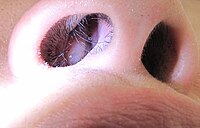
Photo from wikipedia
Background The aim of this study is to investigate the potential key genes related to Chronic rhinosinusitis with nasal polyps (CRSwNP). Methods Datasets GSE36830 and GSE72713 were obtained from Gene… Click to show full abstract
Background The aim of this study is to investigate the potential key genes related to Chronic rhinosinusitis with nasal polyps (CRSwNP). Methods Datasets GSE36830 and GSE72713 were obtained from Gene Expression Omnibus. Dataset GSE36830 was used to identify differentially expressed genes in CRSwNP patients. GO, KEGG analysis, and PPI network analysis were applied to further investigate the function of DEGs in CRSwNP. GSEA was also performed to explore the mechanisms of DEGs. Dataset GSE72713 was applied to validate the key gene. Moreover, to detect the expression of target gene, nasal polyp tissues and middle turbinate specimens were collected from CRSwNP patients (n = 20) and controls (n = 20), respectively. RT-PCR, Western blot, and immunofluorescence staining were applied. HE and AB-PAS staining were used to assess the infiltration of inflammatory cells. The proliferation and migration ability of human nasal epithelial cells (HNEpCs) were tested via Cell Counting kit-8, wound healing assay and Transwell migration assay. Air–liquid interface was used to culture primary human nasal epithelial cells (pHNECs) from health controls and nasal polyp tissues of CRSwNP patients. Results A total of 1035 DEGs were identified, and 661 genes were up-regulated and 374 genes were down-regulated. According to PPI network analysis, the top 10 scored genes were identified. Among them, only EGF was down-regulated in CRSwNP. Meanwhile, GSEA result shows that EGF is significantly enriched in WNT activated receptor activity. CCK-8, wound healing assay, and transwell migration assay indicated that recombinant human EGF can promote the proliferation and migration of HNEpCs in vitro. Immunofluorescence staining shows that rhEGF can increase the expression of ZO-1 in pHNECs from nasal polyp tissues. Conclusion Bioinformatics analysis and in vitro experiments were used to explore the pathogenesis of CRSwNP, and the results showed that EGF may play an important role in the protection of nasal epithelial barrier.
Journal Title: Journal of Inflammation Research
Year Published: 2022
Link to full text (if available)
Share on Social Media: Sign Up to like & get
recommendations!